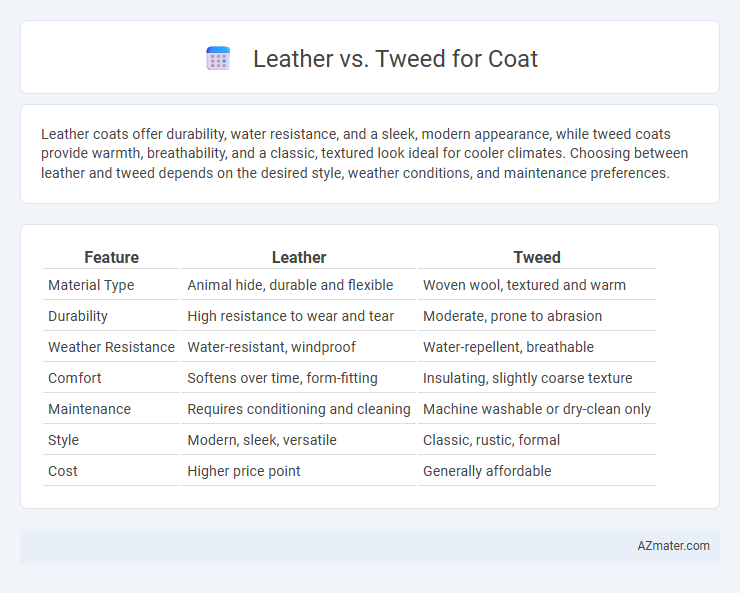Leather coats offer durability, water resistance, and a sleek, modern appearance, while tweed coats provide warmth, breathability, and a classic, textured look ideal for cooler climates. Choosing between leather and tweed depends on the desired style, weather conditions, and maintenance preferences.
Table of Comparison
| Feature | Leather | Tweed |
|---|---|---|
| Material Type | Animal hide, durable and flexible | Woven wool, textured and warm |
| Durability | High resistance to wear and tear | Moderate, prone to abrasion |
| Weather Resistance | Water-resistant, windproof | Water-repellent, breathable |
| Comfort | Softens over time, form-fitting | Insulating, slightly coarse texture |
| Maintenance | Requires conditioning and cleaning | Machine washable or dry-clean only |
| Style | Modern, sleek, versatile | Classic, rustic, formal |
| Cost | Higher price point | Generally affordable |
Introduction: Leather vs Tweed Coats
Leather coats offer durability, water resistance, and a sleek, edgy style, making them ideal for both casual and formal wear. Tweed coats provide excellent insulation, breathability, and a classic, textured appearance suited for colder climates and traditional fashion. Choosing between leather and tweed hinges on climate, style preference, and functional needs.
Material Overview: Leather and Tweed Explained
Leather, derived from animal hides, is a durable, weather-resistant material prized for its smooth texture and ability to age with character. Tweed, a woolen fabric originating from Scotland, offers warmth, breathability, and a distinctive rough texture with patterned weaves such as herringbone or checks. Both materials serve functional and aesthetic purposes in coats, with leather emphasizing sleek protection and tweed focusing on insulation and classic style.
Durability Comparison
Leather coats offer superior durability due to their resistance to wear, tearing, and water exposure, making them ideal for long-term use and harsh weather conditions. Tweed, while robust and highly resistant to abrasion and aging thanks to its dense wool fibers, may be more prone to pilling and moisture damage over time. The longevity of leather typically exceeds tweed when properly maintained, highlighting its advantage in durability for outerwear.
Weather Resistance and Seasonal Suitability
Leather coats offer superior water resistance and windproof qualities, making them ideal for damp, windy, or cold weather conditions. Tweed coats, crafted from dense wool, provide excellent insulation and breathability, suitable for cool, dry autumn or early spring days. While leather excels in harsh, wet climates, tweed remains a popular choice for moderate, crisp weather due to its natural warmth and moisture-wicking properties.
Style and Versatility
Leather coats offer a sleek, edgy style that effortlessly complements both casual and formal outfits, making them highly versatile for urban and evening wear. Tweed coats deliver a classic, textured appearance ideal for business and smart-casual settings, adding sophistication with enhanced warmth for colder climates. Choosing between leather and tweed depends on preferred aesthetics and occasion, with leather providing bold modernity and tweed offering timeless elegance.
Comfort and Breathability
Leather coats provide excellent wind resistance and durability but often lack breathability, which can result in discomfort during extended wear or in warmer conditions. Tweed coats, made from woven wool fibers, offer superior breathability and natural insulation, making them ideal for moderate to cool climates. The soft, flexible texture of tweed enhances comfort by allowing better air circulation and moisture absorption compared to the stiffer, less porous surface of leather.
Maintenance and Care Requirements
Leather coats require regular conditioning to prevent drying and cracking, along with careful spot cleaning and professional leather cleaning to maintain suppleness and shine. Tweed coats demand gentle brushing to remove dirt, occasional spot cleaning, and dry cleaning to preserve the fabric's texture and prevent shrinkage. Proper storage, avoiding moisture for leather, and moth protection for tweed significantly extend the lifespan of each coat type.
Cost and Value for Money
Leather coats typically have a higher initial cost due to premium materials and craftsmanship, offering durability and timeless style that can justify the investment over time. Tweed coats are generally more affordable and provide excellent insulation and versatility, making them a cost-effective option for seasonal wear. Evaluating value for money depends on your budget and desired longevity, with leather offering long-term durability and tweed delivering practical warmth at a lower upfront price.
Eco-Friendliness and Sustainability
Leather coats often have a higher environmental impact due to animal farming, chemical tanning processes, and longer biodegradation times, whereas tweed, typically made from natural wool fibers, offers better biodegradability and renewable sourcing. Sustainable tweed production emphasizes organic or recycled wool, reducing carbon footprint and avoiding harmful pesticides, thus aligning with eco-friendly fashion principles. Choosing tweed over leather supports reduced resource consumption and promotes circular fashion through biodegradable materials and lower greenhouse gas emissions.
Final Verdict: Choosing the Right Coat Material
Leather coats offer durability, water resistance, and a sleek, edgy aesthetic ideal for urban environments, while tweed coats provide superior warmth, breathability, and classic style suited for colder, rural settings. The choice depends on lifestyle needs; leather is perfect for those seeking a low-maintenance, fashionable outer layer, whereas tweed excels in insulation and traditional elegance. Prioritize function and climate--leather for rugged, weather-resistant wear; tweed for cozy, timeless sophistication.

Infographic: Leather vs Tweed for Coat
 azmater.com
azmater.com